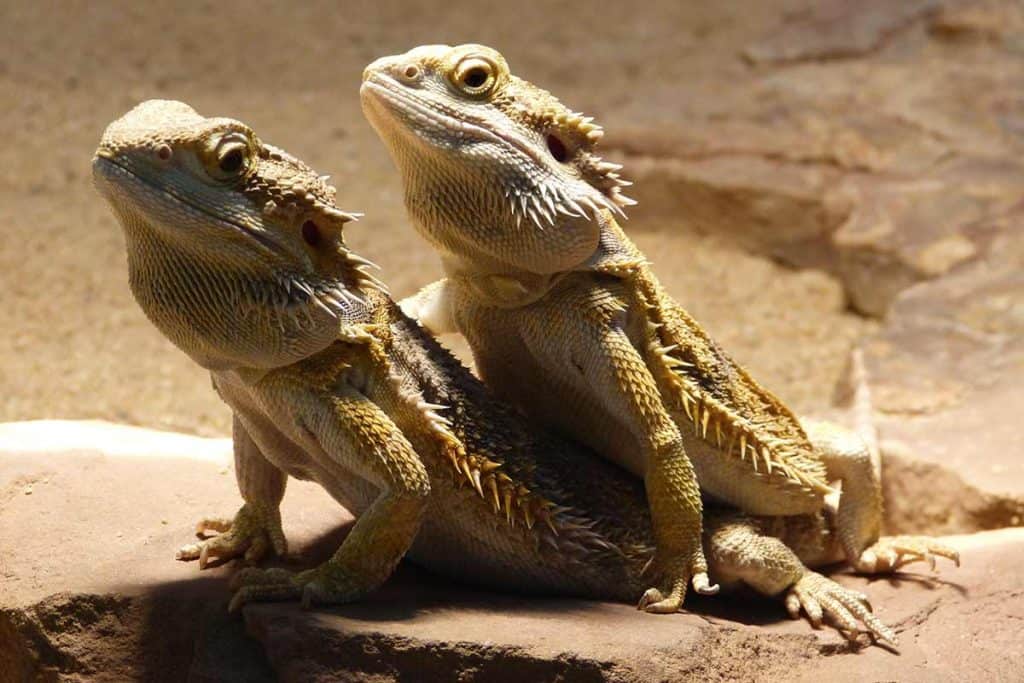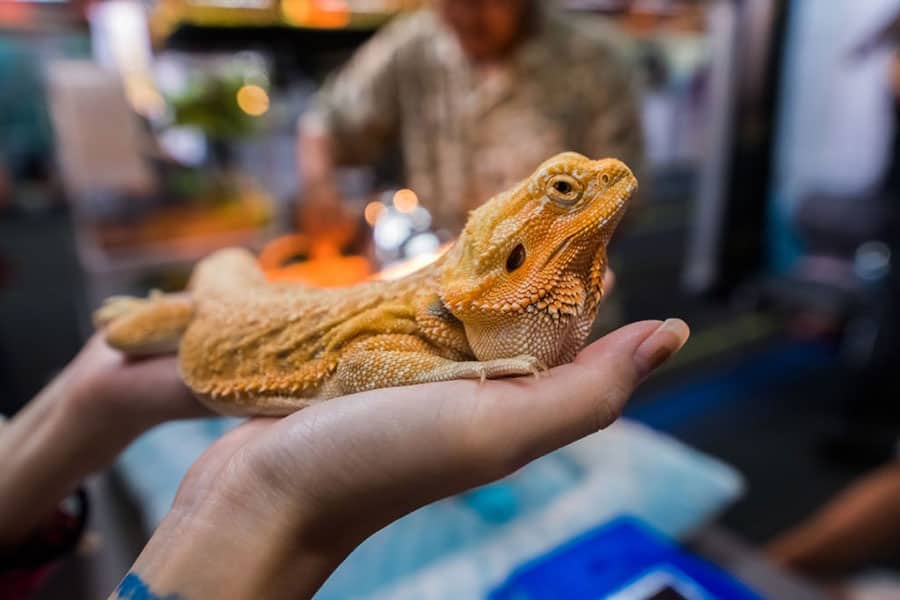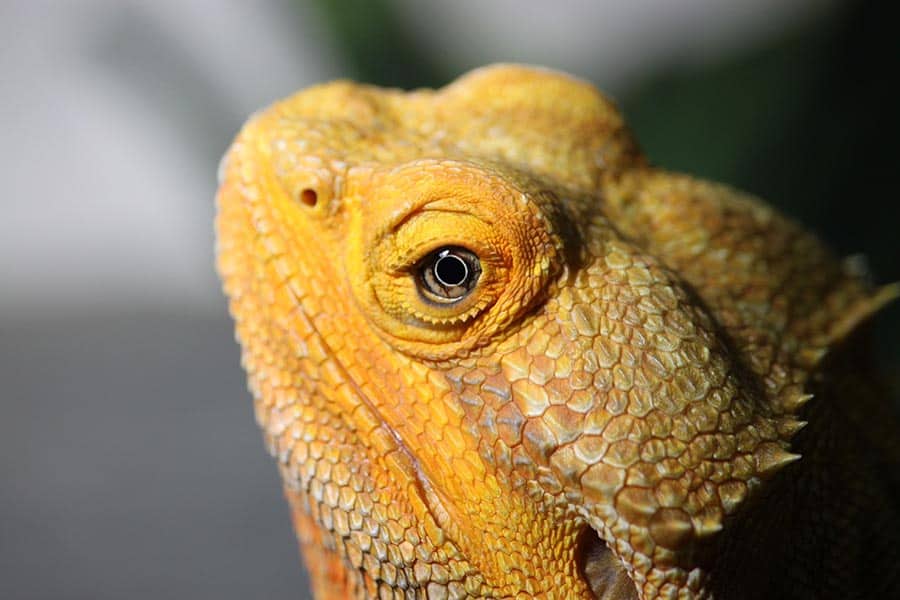What exactly does it mean to sex a bearded dragon?
Teens and tweens probably giggle every time they hear this phrase, and even as an adult, you may think it’s related to making beardie babies. But sexing bearded dragons isn’t about getting pairs to mate and lay eggs. It simply describes the process of finding out if your scale baby is a boy or a girl.
When you’re a pet parent, the sex of your scale baby matters a lot. And it’s not just about preference; male and female beardies often have different care needs. Additionally, they might require varied diets depending on their species to stay happy and healthy.
But figuring out how to sex a bearded dragon can be tricky. They’re not as visually distinct as other pets, so you might have to look closer at their body sizes and physical characteristics to tell the difference between males and females.
But even size alone is not a definitive way to tell a bearded dragon’s gender. After all, other factors like age, health status, diet, and subspecies all influence the size of a bearded dragon. Yes, you could ask the vet to help you sex your beardie, but vet fees can hit over $100 per session.
You could also ask the pet store or the breeder you purchased your dragon from about the sex of your pet. Unfortunately, pet stores aren’t as stringent as breeders, so they might not know. Some reptile rescues are great about sexing beardies, but if it’s run by volunteers, they may not be professionally trained.
The most important to remember when sexing your bearded dragon is to make sure your scale baby feels safe. You may need to hold them at awkward angles, and nobody enjoys having their privates mishandled. Focus on both your beardie’s physical and psychological comfort as you examine them.
How to Sex a Bearded Dragon: The Hemipenes
The best way to verify the gender of your bearded baby is to look closely under their tail. You will notice either two hemipenal bulges for a male or one vaginal bulge for a female. You can sometimes spot these bumps when your bearded dragon is as young as a week old, but it won’t be as obvious until they are a bit older.
You may have heard some male reptiles have two sexual organs. These organs are called hemipenes. Interestingly, female reptiles often have two sexual organs too, such as dual clitorises, which is also called a hemiclitoris.
In bearded dragons, you can’t see their hemipenes hanging out of their body. They’re internal bulges positioned under the tail. If you hold your dragon up and examine the area around their tail, you’ll notice two bulges (if they are male) or one (if they are female).
If this sounds confusing, just look for your bearded dragon’s ‘anal vent’ or cloaca. Beardies, like most reptiles, poop and pee in one bowel movement, so their vent houses their sexual organs and handles waste secretions. The solid sections come out first, with uric acid following towards the end.
Your dragon’s anal vent is in the same position whether your bearded dragon is male or female. So, when you’re inspecting the cloaca for your gender reveal, look below the vent (towards the tail), not above the vent (towards the legs and body). We’ll get into more detail on this in a bit.
An experienced vet or breeder can tell a bearded dragon’s gender within a week of hatching. However, bearded dragons’ reproductive organs are much easier to see when they hit 2 or 3 months (8 to 12 weeks), and most baby beardies are adopted or purchased at 6 to 10 weeks old anyway.
Curiously, some pet stores and breeders refuse to guarantee a bearded dragon’s sex if the beardie is 6 months or younger. This tells you how easy it is to get those genders crossed, even for professional reptile handlers. Some retailers will let you bring the dragon back for sexing when the lizard is older.
How to Spot the Hemiphenes
How do you tell the sex of a bearded dragon? A bearded dragon’s sex is determined by two factors – chromosomes and environmental temperature. Heat can turn a male dragon into a female while it is still developing inside its egg. If you follow the simple steps below, you’ll have a pretty good idea whether you have a bearded son or daughter.
1. Lift Your Bearded Dragon.
The safest way to handle your bearded dragon is to lift them from below. Slip your arm under the beardie’s body, using an open palm to support their front limbs. Splay your fingers with your thumb and pinkie sitting under the ‘armpits’ and with your forearm along the lizard’s body.
If you’re more comfortable using two hands, one hand can hold the front limbs while your other palm rests below the belly of your beardie. You will need practice, but don’t worry; beardies rarely bite or scratch unless they are under extreme stress, and they will often hiss or whip you with their tail as a warning first.
2. Put Your Palms in a Stable Position Under the Lizard’s Belly.
This is a more convenient way to hold your bearded dragon while you’re working out how to tell bearded dragon gender. Breeders hold beardies this way all the time, but it takes speed, practice, bonding, and confidence. The beardie needs to trust you not to drop them.
Put your palm under your bearded dragon’s belly and raise them very slowly. You want your inner wrist at eye level, so it may help to use a table and crouch rather than raising the dragon to reach you, since that could startle them. And watch out for poop in your face!
3. Tweak Your Beardie’s Tail.
The reason it helps to carry your beardie with one arm is that it leaves your other arm free. So, if you can’t balance your scale baby in one hand, get someone to help you with the next step. You’ll need to gently lift your beardie’s tail without dropping them or startling them.
This may take a few tries as your beardie scrambles to get free. They may try to jump off you and run away. If they do, let them calm down and offer a soothing treat before trying again later. You could bathe them before sexing, as the warm water will help to calm them down.
4. Be Quick, But Also be Gentle.
You don’t have to successfully sex your bearded dragon the first time you try. Like any pet activity, you need patience and practice as you bond with your pet over time. You also need to listen to your pet’s body language cues. Some sexers try to rush before the beardie breaks free, which often results in them being too rough with the lizard.
If you’ve seen any sexing videos, you can see how awkwardly the tail gets pressed when it is bent back to check for bulges. You may also have to pinch the neck or hold the head between your fingers for smaller beardies. Be extra careful not to snap or otherwise damage their neck or tail!
5. Know What You’re Looking for.
The key difference between male and female bearded dragons, and in a lot of other lizards, is their genital bulges. A male has two hemipenal bulges towards the sides of the tail base. Females have one hemipenal bulge towards the middle of the tail base.
When a bearded dragon has three bulges, it probably means their gender shifted from male to female in utero (though this is extremely rare), so here’s a general rule of thumb you could keep in mind to help you remember: odd numbered bulges (1 and 3) mean your dragon is female, while an even numbered bulges (2) on a wider tail base mean your beardie is male.
6. If You Can’t See any Hemipenal Bulges, Try Feeling Around the Vent.
It’s not always easy to spot the hemipenal or hemiclitoral bulges. Try looking at them in good lighting first. If you can’t tell the bearded dragon’s sex by looking, gently caress the base of your beardies tail. Run your fingers down the middle, then rub the sides of the central line.
You should feel the bulges distinctly. If you’re still not sure, run your fingers along the underside of the tail. Next, run a finger across the tail at the base near the joint where it links to the body. This might make it easier to differentiate the ‘flat’ spots from the bulges.
7. Use a Flashlight.
Ideally, you want to check your bearded dragon’s sex in daylight or under bright lighting. Sometimes, it can be quicker to use a flashlight, especially if your bearded baby is wriggly or agitated.
Hold the flashlight above the upper side of the tail while looking under the tail. Be careful not to point it directly into your or your beardie’s eyes. Your beardie’s body will appear to have a red or pinkish tint as their circulation shines through the light, which can make it easier to spot those reproductive nodes.
8. Carefully Flip the Bearded Dragon Over.
Poking around your beardie’s tail can be tricky when you have your hands full. Something else you could try is turning your beardie over. Hold them carefully and lay them on their back so their tail and belly are facing you. Now you can touch the belly to get a better idea of their bulge number and size. Never leave your dragon flipped over for more than 30 seconds or so at most, as their body can put pressure on their lungs, making it difficult for them to breathe when upside-down.
You will also have better access and clearer visuals to the beardie’s tail and their bulges. So check the tail side, first with your eyes, then with your fingers. Gently feel around until you locate the bulges. Spotting two bulges will confirm you have a male bearded dragon on your hands, while one means you have a female.
Secondary Clues
Aside from the hemiphenes, you may find other telltale clues elsewhere in your beardie’s body.
Femoral Pores
Some tips you’ll hear about sexing a bearded dragon seem obvious. You’ll hear talk of checking their femoral pores. Your dragon’s femoral pores are on the undersides of their hind legs, and they secrete pheromones to attract a mate. Males often have larger, more distinct femoral pores.
But female pores can be big too, especially during ovulation, so this indicator alone is not always 100% accurate.
Head Size
Other minor verifiers include head size. Male beardies often have a bigger, broader head and tail. Females may have broader bellies but thinner tails.
Cloaca
Bearded dragons only have one underbelly opening – their cloaca or vent. They use this for pooping, mating, and laying eggs. And while all beardies have their reproductive organs directly below the cloaca (on the tail side), the cloaca itself has slight gender differences.
It’s not as easy to distinguish, but males have a wider, more slit-like cloaca, while females have a narrower but broader one. This difference is most obvious after the (female) beardie has laid a clutch or two. By then, you’ll already know whether your beardie is a Gene or a Gina!
Belly
You could also touch the belly area – female beardies often have a larger, softer tummy that can expand more easily to hold eggs. This is easier to spot after puberty (8 months and over).
FAQs About Bearded Dragon Sex
Is it possible to know their sex without touching them?
Usually, no, since you will probably have to closely inspect their reproductive organs, which are easiest to see by examining and feeling around near your dragon’s vent.
Sure, you could put them on a see-through glass table and look at them from below or squat under their tank if it has a transparent glass floor and you’ve removed their substrate. Even then, though, they’re unlikely to stay still and let you look when they can see you crouching under them. You could always compare the organs of two beardies, but you’d still have to touch them and have another dragon on hand to compare yours to.
Do female bearded dragons have beards?
Yes, they do. The ‘beard’ is a spiky section between their chin and neck. The beards have sensitive spikes, and the beard can bulge and puff out in both males and females.
A female beardie will darken her beard on occasion, but this is rare, and it doesn’t get as dark as males’ beards. Males puff their beards out and darken them when threatened, and they mostly do this with predators and other males. That said, even when they’re relaxed and calm, you can’t conclusively use the beard to distinguish your beardie’s gender.
Can I use another bearded dragon to help me sex my beardie?
This could be helpful, yes, but you don’t want to antagonize your beardie or force them to blacken their beard. Still, their behaviour around other dragons can be a clue.
If you put two male beardies together, the dominant one will probably puff up, hiss, and bob his head, while the weaker one will do a submissive wave, but females will exhibit similar submissive behaviors as well.
How does a bearded dragon get a sex change?
Some marine and reptile species have both sets of reproductive organs, meaning they can change their gender in some situations. However, once a bearded dragon is born, their sex stays the same throughout their lives.
That said, bearded dragons can sometimes change their sex before they hatch. Remember, bearded dragons are cold-blooded. So, while they’re still inside their eggs, if the outside temperatures get too high, a male beardie embryo could ‘turn female’.
In these rare cases, the dragon will still have male organs and hemipenal bulges, but he’ll hatch as a ‘social female,’ meaning it can submit to males, ovulate, breed, and lay eggs. These “reversed” females tend to lay more eggs than cis females.
What happens if you get your beardie’s sex wrong?
You might house two males together, thinking one is female. As a result, the dragons could end up fighting and hurting each other, since males can get territorial.
Alternatively, you might put a male and female together thinking they’re both female. If the dragons end up breeding too early, it can weaken the female’s health and shorten her lifespan. Similarly, if you accidentally keep a female thinking she’s a male, she may experience egg-binding problems, which you wouldn’t be on the lookout for.
When in Doubt, See a Vet
So, while you can sex a bearded dragon at home, you may still be surprised when what you thought was your bearded son suddenly bears you grandkids. In such cases, a vet visit can help. The vet can confirm if your beardie has male and/or female organs and suggest what to do.




